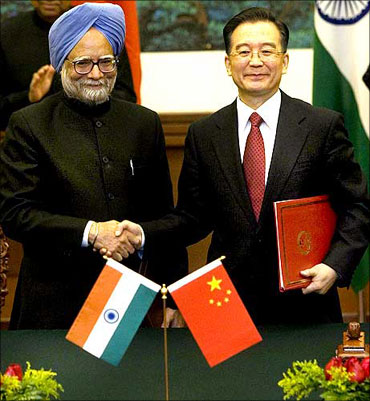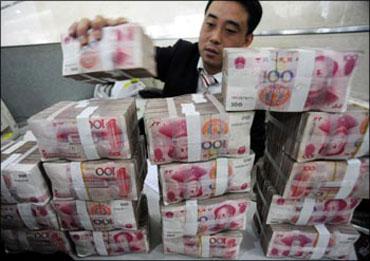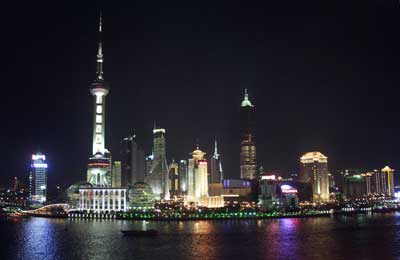 | « Back to article | Print this article |
Why India may beat China in sustaining high growth
With talk of a G2 running the world, there is no more important question for India than to form a judgment on where China is headed economically and politically. This is the subject of this column and the next.
First, the economics. In many ways, there are eerie parallels between assessments of the Chinese economy today and Japan's at the end of the 1980s. Remember books called 'Japan as No. 1', just before the Japanese stock market and property bubble collapsed and Japan entered a near two-decade period of economic stagnation and deflation.
Whilst the Japanese accumulated trade surpluses were used to go on a shopping binge from movie studios to Impressionist paintings, which had to be sold at a loss with the subsequent economic retrenchment.
The preceding investment boom was caused by dodgy investments promoted by low interest rates which often had negative real rates of return, so that the household sector 'managed to incur real capital losses of 405.8 trillion yen' on their accumulated savings of 1,250 trillion yen between 1970 and 1988, as estimated by Albert Ando.
Click NEXT to read on. . .
Why India may beat China in sustaining high growth
China today is being congratulated for its massive fiscal and monetary stimulus which, after a short growth recession, has returned it to its 10 per cent per annum growth path.
But unlike the source of past growth through labour-intensive exports, this recent growth surge is entirely due to massive public investment, mainly in infrastructure, which Yao Yang of Peking University argues has very low rates of return.
Whilst the accumulated foreign exchange reserves of $3 trillion, held in large part in the United States and eurozone public debt instruments, are beginning to look more like the unprofitable deployment of Japanese surpluses by its private sector in the 1980s.
For, with the ongoing sovereign debt crisis in the eurozone and an incipient one in the US, these Chinese massive holdings of US and eurozone government bonds are beginning to look like the subprime mortgages held by US banks before the Great Crash, with dire consequences for the returns on this deployment of the massive savings of the Chinese people by the state.
Click NEXT to read on. . .
Why India may beat China in sustaining high growth
Finally, the large monetary easing has led to a bubble in the property market, again echoing pre-bust Japan. So, is the latest adherent to the 'Asian' model likely to meet the same fate as its parent?
I do not think so for a number of reasons. The first is that, in Japan, the destruction of its savers by its corporation's low-return investments occurred a decade after the rapid and productive growth based on 'catch-up' in the 1960s and 1970s.
China is still in this catch-up phase and the bad investments it may have made in its recent investment splurge will probably come out in the wash.
With savings rates remaining high, until the demographic dividend ends with the ageing of its population after 2025 and abundant productive opportunities available for industrialisation to expand beyond the coast, and with an elastic supply of labour in a relatively free labour market, it should be able to maintain its stellar growth rate.
Click NEXT to read on. . .
Why India may beat China in sustaining high growth
But this will require it to switch production away from exports to the domestic market. For, the old export-led growth model is unlikely to be tolerated for much longer by the US and Europe.
There are already signs that Chinese policy-makers recognise this, and as their political legitimacy depends upon generating fast labour-intensive growth, they are likely to make this switch in the very near future.
Second, the authorities are already trying to reign in the housing boom by reversing the monetary easing undertaken during the financial crisis.
Third, they are likely to introduce greater exchange rate flexibility fairly soon (on Saturday, China signalled that it would make its currency, the yuan, more flexible against the US dollar), which should ease trade tensions concerning their exports.
Click NEXT to read on. . .
Why India may beat China in sustaining high growth
Fourth, as long as the US and Europe do not resort to the traditional route of inflation whereby debtors in the past have conducted their 'euthanasia of the rentier', the large foreign exchange reserves will continue to give China considerable economic and diplomatic leverage in its economic relations with the rest of the world.
Finally, the reported tensions about rising wages in the coast far from being a sign of distress are the natural accompaniment to the massive increase in the demand for labour its past export-led growth has led to in these regions, and can be easily accommodated as is already being signalled by the authorities.
So, for at least the next decade, the Chinese should be able to maintain their 9-10 per cent per annum growth rates. There is no immediate danger that they will end up like Japan in the late 1980s.
But there is a longer term danger in following the 'Asian model' after the catch-up phase ends. In an important book, Yaseng Huang (Capitalism with Chinese Characteristics) has argued that the authoritarian state-led capitalist model that the Chinese have followed since the 1990s, after the more liberal entrepreneurial capitalist model instituted by Zhao Ziyang in the 1980s, is inferior to the Indian model because of the stunted size of the Chinese indigenous private sector and the continuing reliance on financial repression which are its hallmark.
Click NEXT to read on. . .
Why India may beat China in sustaining high growth
His most alarming finding is that there has been a marked decline in total factor productivity in China since the late 1990s. India, he argues, has progressed further than China in financial liberalisation, and its private sector-led model since 1991 has fostered indigenous entrepreneurship, whereas China is still dominated by highly profitable state monopolies with 'private sector businesses operating on the margins of technology and innovations'.
This has meant that India has generated growth rates close to China's with much lower investment. He also notes that in 1980, China started with an infrastructure disadvantage compared with India, and yet had spectacular growth rates. So, like India today, 'FDI and infrastructural investment played a minor role in China's initial economic take-off'. They have followed rather than led growth.
He concludes that India has a better chance of maintaining high, sustainable growth rates than China. Talk of a G2 dominating the world economy is thus premature.






